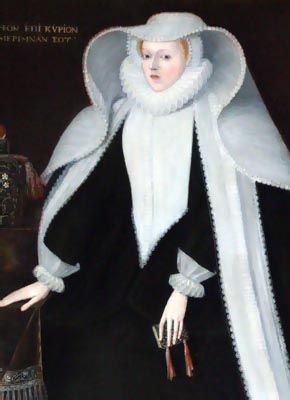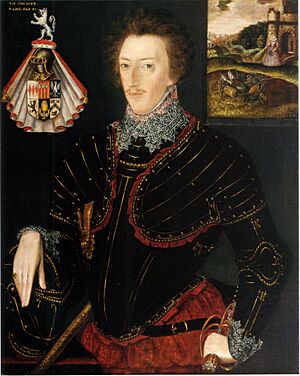Elizabeth Cooke, Lady Russell facts for kids
Elizabeth Russell, Lady Russell (born Cooke; formerly Hoby; 1528–1609) was an English poet and noblewoman. She was an important person at Queen Elizabeth I's royal court. People in her time knew her for her beautiful poetry and her musical skills. In 1596, she strongly spoke out against rebuilding the Blackfriars Theatre in London.
Contents
Elizabeth Russell's Life Story
Elizabeth was born at Gidea Hall, Essex, England. She was the third daughter of Anthony Cooke, who was a teacher to Edward VI, who later became king. Her father made sure all four of his daughters received an excellent education, which was unusual for women back then. Her sister, Anne Bacon, also became a famous scholar. Elizabeth herself was very good at Latin and French.
First Marriage and Family Life
Elizabeth's first marriage was on June 27, 1558, to Thomas Hoby. He lived at Bisham Abbey in Berkshire. Thomas Hoby was known for translating a famous book called The Book of the Courtier into English. In March 1566, he became a knight and was sent to France as the English ambassador. Elizabeth and Thomas moved to Paris. Sadly, Sir Thomas Hoby died there in July of that same year. Queen Elizabeth I sent Elizabeth a very kind letter to comfort her.
Elizabeth had four children with Sir Thomas Hoby. Their son Edward was born in 1560. They had two daughters who both passed away in childhood in 1571. After Thomas Hoby's death, another son was born, who was named Thomas Posthumus (meaning "born after his father's death"). Elizabeth built a special chapel to remember her husband in the church at Bisham.
Second Marriage and Court Connections
In 1574, Elizabeth married again to John, Lord Russell. He was the oldest son of Francis Russell, 2nd Earl of Bedford. Elizabeth had two daughters with John: Anne and Elizabeth. John Russell died in 1584. Because he died before his father, Elizabeth could not become the Countess of Bedford.
Elizabeth had strong connections at court. Her brother-in-law was William Cecil, Lord Burghley, a very powerful advisor to the Queen. Her nephew was Robert Cecil. These connections helped her in legal matters and when she sought favors for herself and her friends. Her son, Thomas Posthumus, even became a special helper to Lord Burghley.
Relationship with Queen Elizabeth I
For a while, Queen Elizabeth I liked Elizabeth Russell very much. In the summer of 1592, the Queen even stayed at Bisham Abbey for six days as Elizabeth's guest. The Queen's special council, the Privy Council, also met there. It is said that the Queen was a godmother to two of Elizabeth's children. However, by 1595, Elizabeth found it harder to see the Queen, only being able to meet her at church. But by June 1600, she was back in the Queen's good graces. The Queen attended her daughter's wedding at Blackfriars.
Interests and Later Life
Elizabeth Cooke was known for supporting musicians, especially the composer John Dowland. She also translated a religious book from French into English, which was printed in 1605. She wrote inscriptions for tombs in Greek, Latin, and English.
In 1596, she strongly opposed the rebuilding of the Blackfriars Theatre. She was a very religious Puritan and did not approve of live plays. She even created a petition, which is a formal request, against the new theatre. Blackfriars was a fancy part of London. Some people who signed her petition were even business partners of William Shakespeare. However, her efforts to stop the theatre failed.
Elizabeth was a very determined woman. She was very keen on getting and protecting her own property. She was even the first woman to be the keeper of her own castle in England.
Later in her life, she often went to court to settle disagreements through law. Elizabeth died at her home in Bisham, Berkshire. She is buried in the 'Hoby Chapel' at All Saints Church in Bisham. A grand monument was built there to honor her.
Images for kids





